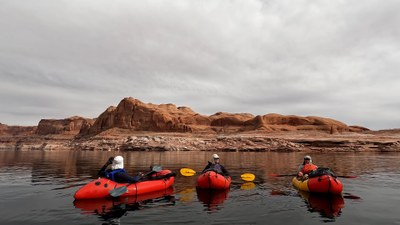
Packrafting Course
Introduction to Flatwater Packrafting
A basic introduction course to learn how to safely and proficiently packraft on flat bodies of water, how to pack and hike with your packraft, and how to efficiently pack camping gear in your packraft.
- Thu, Sep 7, 2023 - Sun, Oct 15, 2023
- Committee: Seattle Packrafting Committee
- Members: $295.00 Guests: $325.00
- Availability: FULL (10 capacity)
- Cancellation & Refund Policy
This course is suited for outdoor adventurers who want to further their range into, and out of, the backcountry using a packraft. We introduce students to the essential skills of packrafting on flatwater, such as alpine lakes and slow moving rivers. The capstone of the course will be an overnight trip involving hiking, boating, and camping. For those students unable or uninterested in an overnight trip, a day trip option will be available.
There are four outings included with this course:
- An evening gear lecture
- A field trip on a lake
- A field trip on a class I river
- An experience trip, two options will be available: an overnight hiking-paddling-camping trip, or a day trip
Participants must attend all outings and demonstrate proficiency in essential skills in order to graduate. Please note the gear lecture is an evening lecture on Sept. 7th in person at the Mountaineers Program Center in Seattle.
Skills
COLD WATER SWIMMING AND RESCUE
- Float for 5 minutes in a lake
- Swim 100 feet (30m) in a lake without paddle
- Swim 100 feet (30m) in a lake with a paddle
- Execute a flat jump into a Class I river
- Swim in a Class I current in the safety position and back ferry to move laterally
- Swim in a Class I current cross current at a ferry angle in the aggressive swim position
- Transition to and maintain a safety position
- Throw a rope to a swimmer and guide them to shore
- Swim to a rope and hold in the position for rescue
BOAT RIGGING AND GEAR KNOWLEDGE
- Packraft inflation, rigging, deflation and care
- Drysuit donning, doffing and care
- Perform a mock boat repair
- Packing one's packraft, paddle, and gear into a backpack
SELF RESCUE SKILLS
- Capsize and wet exit in flat water
- Self-reentry from deep water in 90 seconds
- Reenter a stabilized boat in deep water
GROUP RESCUE
- Paddle to a swimmer; bring a swimmer 50 feet (15m) to their boat using the koala carry and rear tow methods
- Right a capsized boat; bring a boat 50 feet (15m) to a swimmer using the bow carry and boat bump methods
- Stabilize a swimmer's boat while they reenter
- Collect a floating paddle and carry an extra paddle 50 feet (15m)
FLAT-WATER READING AND HAZARDS
- Identify wood hazards and how to avoid them
- Read braided rivers, identify cobble bars, and pick through lines
- Read wind on flat water and coping strategies
- Identify chop and paddle through it
PADDLING SKILLS
- Launch from a shallow lake entry
- Draw stroke sideways for 5 feet (2m)
- Scull stroke sideways for 10 feet (3m)
- Paddle in a figure 8 within 50 feet (within 15m)
- Launch from a rocky shoreline into Class I current
- Ferry paddle 30 feet (10m) across a Class I current
- Paddle 30 feet (10m) through a Class 1 riffle
- Break through a well defined eddy line near shore and at a mid-stream boulder
- Demonstrate the ability to manage boat speed and spacing by choosing slower water, catching eddies, or backpaddling
Badges you will earn:
This course has no scheduled activities.
The big items needed for this course are a packraft and a dry suit. In this course you will be entering and exiting cold bodies of water numerous times on each wet training day. A dry suit is highly recommended and may be rented at a local shop. A thick, multi-layer wetsuit may suffice for those who have a high tolerance for cold.
The other large item needed is a packraft. The club has several packrafts available for students to rent for $200 for the duration of the course and a 2 month period beyond the course.
In addition to the big two items described above, a PFD, paddle, waterproof whistle, neoprene booties, neoprene gloves, a repair kit, dry bag and other miscellaneous items will be required. We will cover all of these items in the gear lecture.
For the overnight trip, the club has several tent/camp kits available. Students may also join the Mountaineers gear library and borrow camping gear that way.
You must register for this course to see course materials.

 Flatwater Packrafting
Flatwater Packrafting